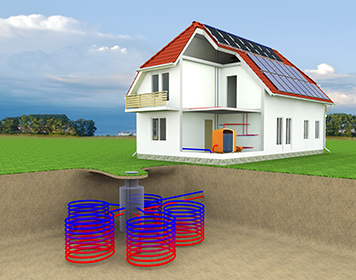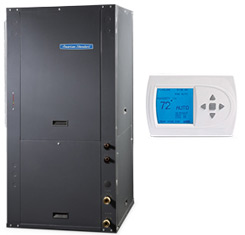Buildings represent 40% of the energy consumption of modern civilization according to the International Energy Agency, and 33% of greenhouse gas emissions. In the case of homes and commercial buildings, space heating and air conditioning are among the top energy expenses
 Credits: WestberryHVAC.com
Credits: WestberryHVAC.com
Geothermal heat pumps are a promising technology since they can accomplish both functions at a minimum energy cost. They also run 100% with electricity, which means there is no need to burn fossil fuels onsite for heating purposes.
Heat pumps use the same principle as refrigerators and air conditioners. They use the repeated compression and expansion of a refrigerant to carry heat from a cooler location to a warmer location (opposite to the natural direction of heat flow).
- The refrigerant is allowed to expand with a special valve, causing its temperature to drop even below the outdoor temperature.
- This way the refrigerant can capture heat from the outdoor environment, even if the temperature may seem cold for a human being.
- Once the refrigerant has absorbed outdoor heat, it goes through a compression process that heats it above the indoor temperature.
- Now the refrigerant can release heat indoors, and the cycle can be repeated.
The efficiency of a heat pump greatly depends on the source of thermal energy. An air-source heat pump or ASHP extracts heat from outdoor air, as you might guess from its name. However, their efficiency drops when exterior temperatures are very low – most ASHP struggle when the outdoor temperature drops below 0°F.
On the other hand, a ground-source heat pump or geothermal heat pump exchanges heat with the underground, where temperatures are much more stable throughout the year.
Many geothermal heat pumps are also designed for reversible operation, which means they can act as highly efficient air conditioners during summer.
Assuming you compare equipment of the same capacity, a GSHP is more expensive than an ASHP since there are buried components involved.
Installing an ASHP is not very different from installing a split-type air conditioning system, while a GSHP involves excavations to access suitable underground temperatures.
In exchange for a higher upfront cost, you get superior energy efficiency with a GSHP.
While an air-source heat pump uses 2-4 times less energy than a traditional resistance heater, a geothermal heat pump uses 3-6 times less energy.
Main Benefits of a Geothermal Heating and Cooling System
A geothermal heat pump offers two main benefits for homeowners and businesses:
- Lowering your electricity and fossil fuel costs.
- Reducing your property’s greenhouse gas emissions.
Geothermal heat pumps are characterized by their superior energy efficiency, and they can lower your bills all year long if you purchase a reversible unit.
You save on air conditioning during summer, and you save on space heating during the winter. A GSHP also saves space, since two different mechanical systems are being combined into a single unit.
Since geothermal heat pumps run only with electricity, they can also reduce the direct emissions produced by your home or business.
Traditional furnaces and boilers operate with fuels like natural gas, propane, and fuel oil – this means your property is constantly releasing emissions during winter.
- While a traditional resistance heater can also provide fully electric heating, the high operating cost is a disadvantage.
- A heat pump can deliver the same heating output while reducing energy consumption by around 50-80%.
Depending on where you live, a geothermal heating and cooling system may qualify for cash rebates or other financial incentives. The Inflation Reduction Act introduced nationwide tax credits and rebates for energy efficiency measures, and this includes heat pump systems.
How Much Does a Geothermal Heat Pump Cost?
The cost of installing a geothermal heating and cooling system can vary widely depending on underground conditions in your property. However, you can generally expect to invest more than $10,000 when installing a residential GSHP.
Depending on the difficulty of excavations and the size of your property, the cost of a geothermal heating and cooling system can reach the range of $30,000 – $50,000.
Thanks to the Inflation Reduction Act passed in August, homeowners who install energy efficiency measures can qualify for rebates of up to $14,000, and federal tax credits of up to $2,000 per year.
If you’re considering a geothermal heat pump system, these new incentives can greatly reduce your upfront costs:
- Investment Tax Credit for Clean Energy Property
- Homeowner Managing Energy Savings (HOMES) Rebate Program
- High-Efficiency Electric Home Rebate Program
The Investment Tax Credit is a 30% deduction for energy efficiency projects, which is subject to a limit of $1,200 per year. However, the tax credit limit is lifted to $2,000 per year in the case of heat pump systems and biomass stoves or boilers.
The HOMES Rebate Program gives you an incentive of $2,000 for home upgrades that reduce your energy consumption by 20-35%, and $4,000 for upgrades that save over 35%.
Considering the high efficiency of a geothermal heat pump, it can help your home qualify for the higher rebate of $4,000. The rebate amount is doubled for households below 80% of the area median income, reaching up to $8,000.
The High-Efficiency Electric Home Rebate Program offers incentives for specific energy efficiency measures. Heat pump system can qualify for up to $1,750 in water heating applications, and up to $8,000 in space heating and air conditioning applications. This incentive is available for households below 150% of the area median income.
The two rebate programs are mutually exclusive, but either of them can be combined with the federal tax credit. Thanks to the Inflation Reduction Act (IRA), a geothermal heating and cooling system can qualify for a potential incentive of up to $6,000 (a $2,000 tax credit and a $4,000 rebate).
Depending on household income level, the heat pump rebate can be increased to $8,000, bringing the total incentive to $10,000.
Summarizing: you can expect to pay between $10,000 and $40,000 when installing a geothermal heating and cooling system. However, you can claim a financial incentive of up to $6,000 when combining the 30% federal tax credit and the HOMES rebates.
How Much Does a Geothermal Heating and Cooling System Save?
The savings achieved by a geothermal heat pump will depend on the HVAC equipment it’s being compared with. However, energy savings of over 50% are typical with respect to traditional space heating and air conditioning systems.
According to the US Department of Energy, the typical American home spends $2,000 per year on energy bills. Space heating and air conditioning account for 54% of the total, which is equivalent to $1,080.
With a geothermal heat pump system reducing your heating and cooling bills by 50%, you would only be spending $540 per year.
A traditional HVAC system for a home has an average cost of $16,000 to $18,000 for complete installation. This figure considers both air conditioning and space heating systems such as a central AC and Gas Furnace combo.
If you choose to install a geothermal heat pump system instead, the investment increases to well more than $25,000.
Assuming your geothermal heat pump system costs $25,000, there is a price differential of $7,000 with respect to a traditional HVAC system installation.
With savings of $540 per year, the simple payback period is over 12-14 years. However, a geothermal heat pump system can last for more than 20 years if serviced properly.
A ground-source heat pump system requires a highly customized design, considering not only your heating and cooling needs, but also soil condition on your property.
An accurate quote and savings estimate is only possible after a professional inspection, but payback periods of 5-10 years are typical in new construction projects according to the US DOE.
Geothermal heat pumps are more cost-effective in new construction projects since you must invest in a new HVAC systems anyway. In this case, a GSHP only represents a cost increase with respect to the amount you would have spent on a traditional system.
Also keep in mind that a GSHP involves excavations, which can be carried out more easily during a well-planned new construction project.
Purchasing a Geothermal Heat Pump: General Recommendations
Like with many other equipment purchases, one of the best recommendations we can give is to look for a geothermal heat pump with the ENERGY STAR label. This means the product has been tested successfully according to federal standards, and you can expect high performance.

ENERGY STAR geothermal heat pumps are also subject to minimum energy efficiency requirements:
- Depending on the type of geothermal heat pump, the minimum energy efficiency ratio to qualify for ENERGY STAR labeling ranges from 16.0 to 21.1
- Geothermal heat pumps with the ENERGY STAR label save $830 per year on average, compared with HVAC systems that meet the minimum federal standards.
A geothermal heating and cooling system can achieve synergy with solar panels. While the GSHP provides heating and cooling at a minimum electricity cost, the solar array generates that power onsite.
Consider that a geothermal heat pump provides up to 6 kWh of heating output for every kWh of electricity consumed. In other words, it can multiply the output of your solar panels.
The first step before installing a geothermal heating and cooling system is deciding if the investment makes sense for your property.
While a GSHP can achieve major energy savings, there are cases where excavation costs are drastically increased due to unfavorable soil conditions. A professional assessment is strongly recommended as the first step.